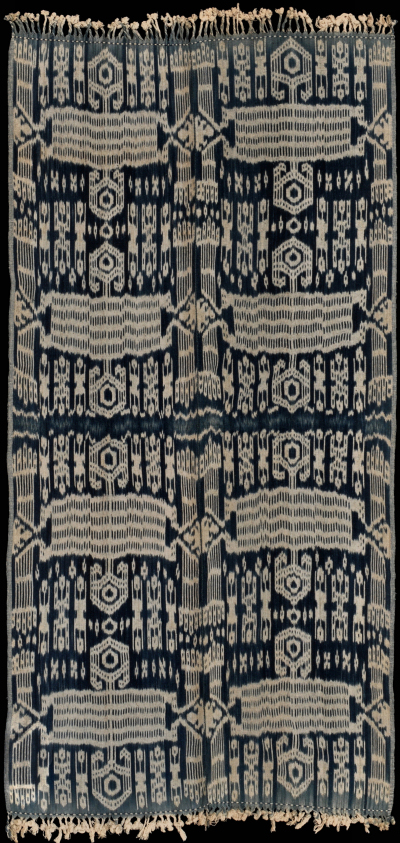| |
 
 | | | |
244 Timor, West Timor
Mau naek (men's wrap)  
| | Locale: | Amanuban, largest of the old Atoni kingdoms, most likely in Niki-Niki | | Period: | Early 20th c. | | Yarn: | Cotton, hand-spun, medium | | Technique: | Warp ikat | | Panels: | 2 | | Size: | 90 x 182 cm (2' 11" x 5' 11") LW: 2.02 | | Weight: | 780 g (27.5 oz), 476 g/m2 (1.56 oz/ft2) | | Design: | Eight large motifs that are reminiscent of the katak or 'frogman' motif popular in the region, but actually represent crocodiles, lafaek, that appear to be double-headed, though one of the two 'heads' probably represents the tail. Spaces in between legs and heads are filled in with two-headed figures that almost certainly represent crocodiles as well. Curiously, the style of the headdress, with the inward curl, which recalls the pilu saluf headdress of a meo warrior, is very similar to that on a Sarawak pua, 037, suggesting that this is an archaic motif with wide distribution. | | Comment: | The fact that the cloth was done in hand spun cotton suggests ceremonial use of great importance, as commercial cotton began to be preferred by most Timorese weavers early in the 20th C. Clearly the work of a master weaver. The narrowest design elements in the finished cloth are four threads wide, meaning that ikating was done in skeins of just eight threads. Deeply saturated indigo, but minimal longitudinal bleeding, a combination that requires very tight bindings. A distinct skatol smell of decomposing indigo attests to its advanced age. The fringes have been knotted into little balls. Ex collection August Flick. | | Background: | Chapters on Timor and West Timor. | | Exhibited: | Hong Kong University Museum and Art Gallery, 2017.
Timor: Totems and Tokens, Museu do Oriente, Lisbon, 2019/20. | | Published: | Ikat Textiles of the Indonesian Archipelago, 2018.
Timor: Totems and Tokens, 2019.
Ikat Textiles of Timor: Indonesian and Timor-Leste, 2025. | | Compare: | 005 112 181 245 037 | | Sources: | Very similar motif on centre panel of a mau from Kotolin in eastern Amanuban in Yeager and Jacobson, Textiles of Western Timor, Fig. 97, identified as 'two-headed human figure'. Gillow, in Traditional Indonesian Textiles shows a Niki-Niki mau with a near-identical pattern on its central panel. The close similarity of the motif would not be enough ground to conclude that this piece also was made in Niki-Niki, but Niki-Niki is also the part of Amanuban where the tendency to eschew side panels and cover the whole cloth in ikat patterning is most pronounced. The motif is identified as representing crocodiles in Cinatti, Motivos Artisticos Timorenses e a sua Integreção, Fig. 97, see below. Given the shape of the legs, Cinatti's interpretation is quite convincing.
 | | |

©Peter ten Hoopen, 2025
All rights reserved.
|
|


